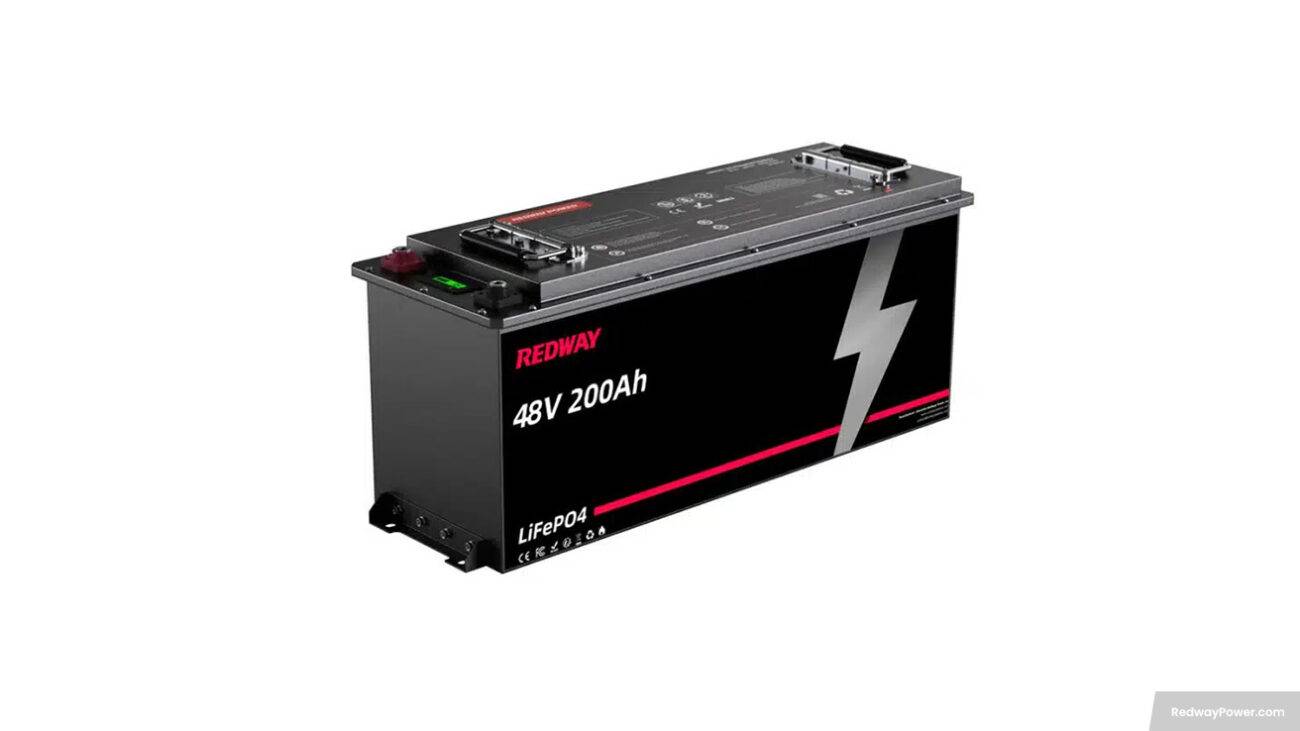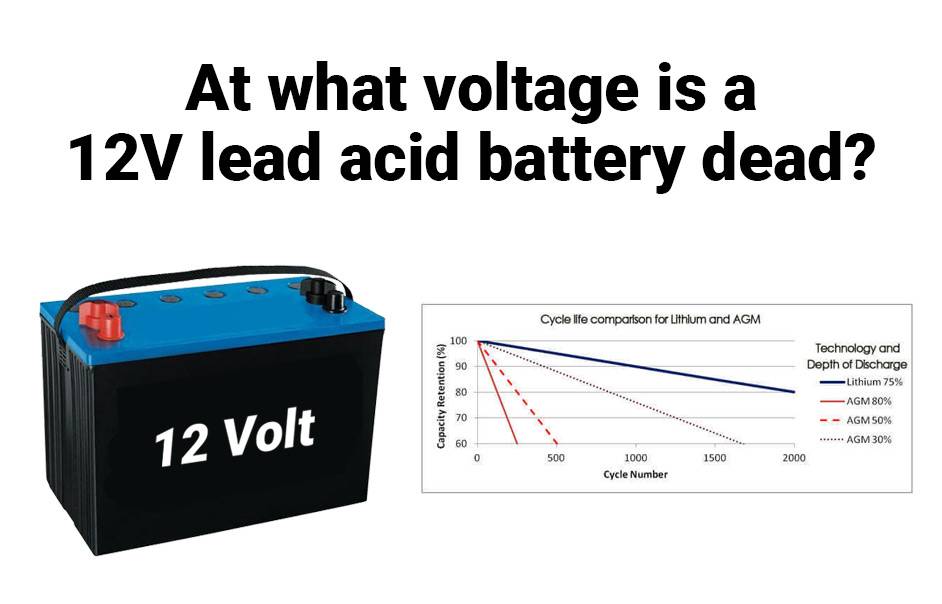- Lithium Golf Cart Battery
- Forklift Lithium Battery
-
48V
- 48V 210Ah
- 48V 300Ah
- 48V 420Ah (949 x 349 x 569 mm)
- 48V 420Ah (950 x 421 x 450 mm)
- 48V 456Ah
- 48V 460Ah (830 x 630 x 590 mm)
- 48V 460Ah (950 x 421 x 450 mm)
- 48V 460Ah (800 x 630 x 600 mm)
- 48V 460Ah (820 x 660 x 470 mm)
- 48V 500Ah
- 48V 560Ah (810 x 630 x 600 mm)
- 48V 560Ah (950 x 592 x 450 mm)
- 48V 600Ah
- 48V 630Ah
-
48V
- 12V Lithium Battery
12V 150Ah Lithium RV Battery
Bluetooth App | BCI Group 31
LiFePO4 Lithium
Discharge Temperature -20°C ~ 65°C
Fast Charger 14.6V 50A
Solar MPPT Charging - 24V Lithium Battery
- 36V Lithium Battery
- 48V Lithium Battery
-
48V LiFePO4 Battery
- 48V 50Ah
- 48V 50Ah (for Golf Carts)
- 48V 60Ah (8D)
- 48V 100Ah (8D)
- 48V 100Ah
- 48V 100Ah (Discharge 100A for Golf Carts)
- 48V 100Ah (Discharge 150A for Golf Carts)
- 48V 100Ah (Discharge 200A for Golf Carts)
- 48V 150Ah (for Golf Carts)
- 48V 160Ah (Discharge 100A for Golf Carts)
- 48V 160Ah (Discharge 160A for Golf Carts)
-
48V LiFePO4 Battery
- 60V Lithium Battery
-
60V LiFePO4 Battery
- 60V 20Ah
- 60V 30Ah
- 60V 50Ah
- 60V 50Ah (Small Size / Side Terminal)
- 60V 100Ah (for Electric Motocycle, Electric Scooter, LSV, AGV)
- 60V 100Ah (for Forklift, AGV, Electric Scooter, Sweeper)
- 60V 150Ah (E-Motocycle / E-Scooter / E-Tricycle / Tour LSV)
- 60V 200Ah (for Forklift, AGV, Electric Scooter, Sweeper)
-
60V LiFePO4 Battery
- 72V~96V Lithium Battery
- Rack-mounted Lithium Battery
- E-Bike Battery
- All-in-One Home-ESS
- Wall-mount Battery ESS
-
Home-ESS Lithium Battery PowerWall
- 24V 100Ah 2.4kWh PW24100-S PowerWall
- 48V 50Ah 2.4kWh PW4850-S PowerWall
- 48V 50Ah 2.56kWh PW5150-S PowerWall
- 48V 100Ah 5.12kWh PW51100-F PowerWall (IP65)
- 48V 100Ah 5.12kWh PW51100-S PowerWall
- 48V 100Ah 5.12kWh PW51100-H PowerWall
- 48V 200Ah 10kWh PW51200-H PowerWall
- 48V 300Ah 15kWh PW51300-H PowerWall
PowerWall 51.2V 100Ah LiFePO4 Lithium Battery
Highly popular in Asia and Eastern Europe.
CE Certification | Home-ESS -
Home-ESS Lithium Battery PowerWall
- Portable Power Stations
How Do Gel Batteries Compare to Lead-Acid Batteries?

Gel batteries, compared to lead-acid batteries, offer superior performance, longer lifespan, and maintenance-free operation, making them a preferred choice for many applications. While they come at a higher initial cost, their durability and efficiency often justify the investment.
What is Gel Battery? What are its advantages?
A Gel battery is a type of sealed lead-acid battery where the electrolyte is immobilized in a gel-like substance created by adding silica to sulfuric acid. This design prevents spillage and allows for safe operation in various environments, making Gel batteries ideal for applications requiring stability and low maintenance.
Gel batteries offer several advantages, including maintenance-free operation, resistance to vibration, and better performance in extreme temperatures. They have a longer lifespan compared to traditional lead-acid batteries, are non-spillable, and produce minimal fumes, making them safer for indoor use and ideal for deep cycle applications.
Let’s explore why gel batteries are a popular choice and what advantages they offer:
- Maintenance-Free: Gel batteries require little upkeep, saving time and effort. Unlike some other types, you don’t need to regularly add water to them.
- Long Lifespan: Gel batteries can last for around 6 years or even more, providing reliable power over an extended period.
- Versatile Installation: You can install gel batteries in various positions without worrying about leaks. This flexibility makes them suitable for different applications.
- Heat Tolerance: Gel batteries handle temperature changes well, remaining stable in both hot and cold environments.
- Leak Prevention: Gel batteries are designed to prevent leaks, ensuring safety and minimizing cleanup hassles.
These advantages make gel batteries a preferred choice for many applications, offering durability, reliability, and ease of use.
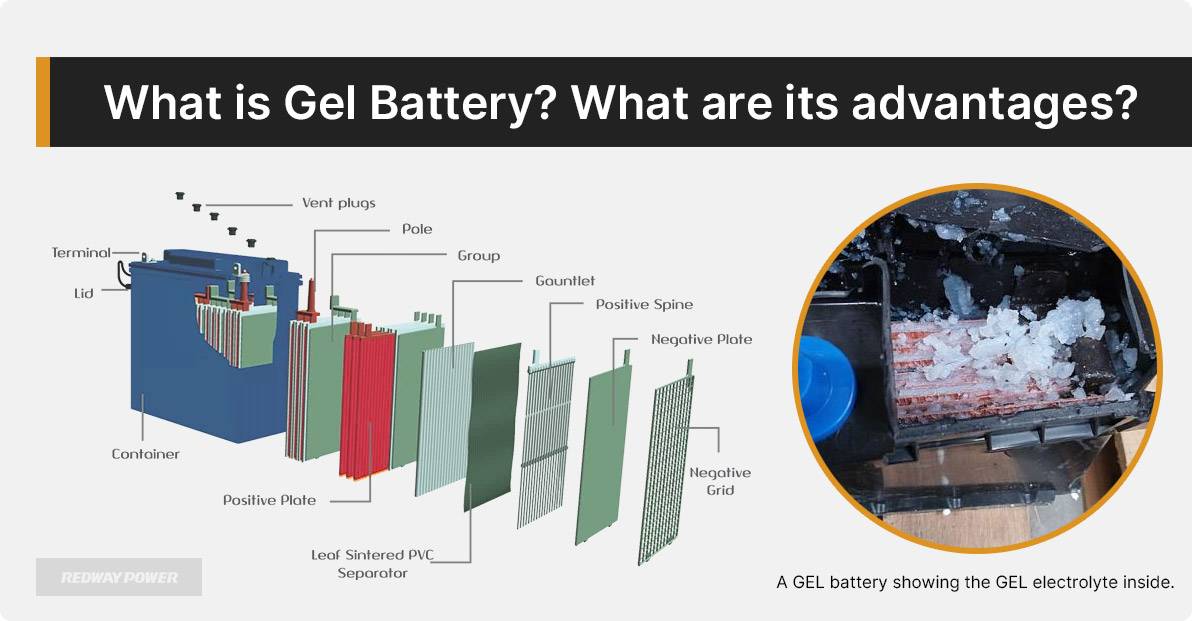
How do gel batteries function?
Gel batteries operate similarly to traditional lead-acid batteries but utilize a silica-based gel electrolyte instead of liquid acid. This design immobilizes the electrolyte, preventing spillage and enhancing safety. The thickened electrolyte allows for deep discharges without damaging the battery, making them ideal for applications requiring consistent power over extended periods. Chart: Gel Battery Functionality
| Feature | Gel Battery | Lead-Acid Battery |
|---|---|---|
| Electrolyte Type | Silica Gel | Liquid Sulfuric Acid |
| Maintenance | Maintenance-free | Requires regular checks |
| Discharge Capability | Deep discharge (up to 80%) | Shallow discharge (up to 50%) |
What are the key features of gel batteries?
Gel batteries possess several notable features:
- Sealed Design: Prevents gas emissions during charging.
- Maintenance-Free: No need for topping up with water.
- Deep Cycle Capability: Can be discharged up to 80% without significant damage.
- Temperature Tolerance: Performs well in extreme temperatures.
These features make gel batteries particularly suitable for applications like solar energy storage, RVs, and marine use.
How do gel and lead-acid batteries perform in comparison?
When comparing performance metrics between gel and lead-acid batteries:
- Lifespan: Gel batteries typically last between 5 to 15 years, while lead-acid batteries last around 3 to 5 years.
- Charging Speed: Gel batteries charge more slowly but require careful charging to avoid damage; lead-acid charges faster but needs monitoring to prevent overcharging.
Chart: Performance Comparison
| Metric | Gel Battery | Lead-Acid Battery |
|---|---|---|
| Lifespan | 5 – 15 years | 3 – 5 years |
| Charging Speed | Slower | Faster |
| Depth of Discharge | Up to 80% | Up to 50% |
What are the cost differences between gel and lead-acid batteries?
Gel batteries generally have a higher upfront cost compared to lead-acid options due to their advanced technology and longer lifespan. However, over time, the overall cost may balance out as gel batteries require less maintenance and replacement frequency.
How do environmental impacts differ between these battery types?
Both battery types have environmental considerations:
- Gel Batteries: Considered safer due to their sealed design; however, they still contain hazardous materials like lead.
- Lead-Acid Batteries: While recyclable, improper disposal can pose significant environmental risks.
Proper recycling practices for both types can mitigate their ecological impact.
When should you choose a gel battery over a lead-acid battery?
Choosing a gel battery is advantageous when:
- You require deep-cycle capabilities without frequent maintenance.
- Your application involves extreme temperature variations.
- Safety from leakage is critical (e.g., in marine or RV applications).
In contrast, if initial cost is a primary concern or if high current demands are needed (like starting engines), traditional lead-acid may be preferable.
What are the latest trends in battery technology?
Recent trends show an increasing shift towards advanced battery technologies like lithium-ion; however, gel and lead-acid remain popular for specific applications due to their reliability and cost-effectiveness. Innovations focus on improving efficiency, lifespan, and environmental impact through better recycling methods.
Industrial News
Recent developments in battery technology highlight a growing interest in sustainable practices within the industry. Companies are investing in research to enhance recycling processes for both gel and lead-acid batteries, aiming to reduce environmental footprints while maintaining performance standards. Additionally, advancements in hybrid systems that combine various battery technologies are gaining traction as industries seek more efficient energy solutions.
Redway Power Insights
“Gel batteries represent a significant advancement in energy storage technology. Their ability to withstand deep discharges without damage makes them ideal for renewable energy applications,” states an expert from Redway Power. “As we continue to innovate within this space, understanding the nuances between different types of batteries will be crucial for consumers looking for reliable energy solutions.”
AGM vs GEL Battery: What’s the Difference? (Which Battery Type is Better?)
FAQs
- How long do Gel batteries last?
Gel batteries typically last between 4 to 6 years under ideal conditions. With proper care and maintenance, they can extend up to 10 years. Factors like usage patterns, depth of discharge, and charging methods significantly influence their lifespan. - Is a lithium battery a Gel battery?
No, a lithium battery is not a Gel battery. Lithium batteries use lithium as an active material, while Gel batteries are a type of lead-acid battery with a gel-like electrolyte. Each type has distinct characteristics and applications.
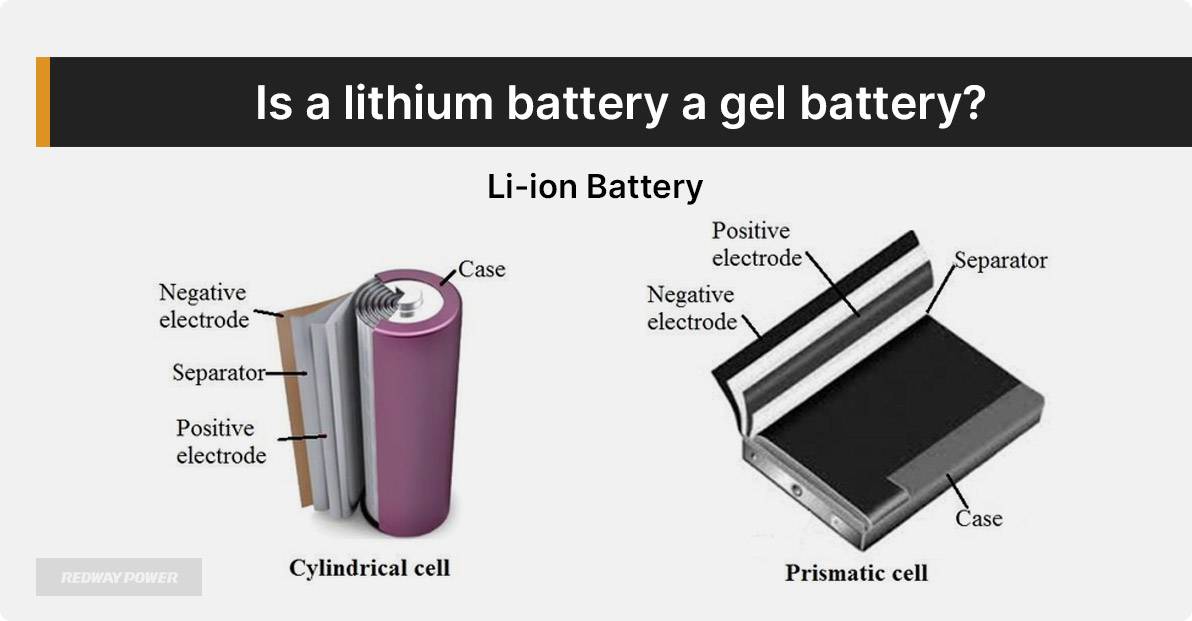
- Can I replace Gel batteries with lithium?
Yes, you can replace Gel batteries with lithium batteries, but ensure compatibility with your system. Lithium batteries offer higher energy density and longer lifespan but may require different charging systems and settings. - What is Lead-Acid Battery? What are its advantages?
A lead-acid battery is a rechargeable battery using lead dioxide and sponge lead as electrodes in sulfuric acid. Advantages include low cost, high reliability, and ability to deliver high surge currents, making them suitable for various applications. - Do lead-acid batteries work in cold weather?
Yes, lead-acid batteries can work in cold weather, but their performance may decline. Cold temperatures reduce the chemical reactions within the battery, leading to decreased capacity and efficiency. It’s advisable to keep them warm for optimal performance. - Key Differences Between Gel Batteries and Lead-Acid Batteries
Gel batteries are maintenance-free and spill-resistant, while traditional lead-acid batteries require regular maintenance and can leak. Gel batteries also have a lower discharge rate and can handle deeper discharges better than standard lead-acid batteries.

- How do you charge a Gel cell battery? Do you need a special charger for gel batteries?
To charge a Gel cell battery, use a charger specifically designed for gel batteries. These chargers regulate voltage to prevent overcharging and ensure safe charging practices, maintaining optimal performance and lifespan. - Do gel batteries need maintenance?
Gel batteries require minimal maintenance since they are sealed and do not need watering. However, regular checks for cleanliness and ensuring proper charging practices can help extend their lifespan. - Can a lead acid battery charger charge a gel battery?
Using a lead-acid battery charger on a gel battery is not recommended. Gel batteries require specific charging profiles to avoid damage; using the wrong charger can lead to overcharging or undercharging.
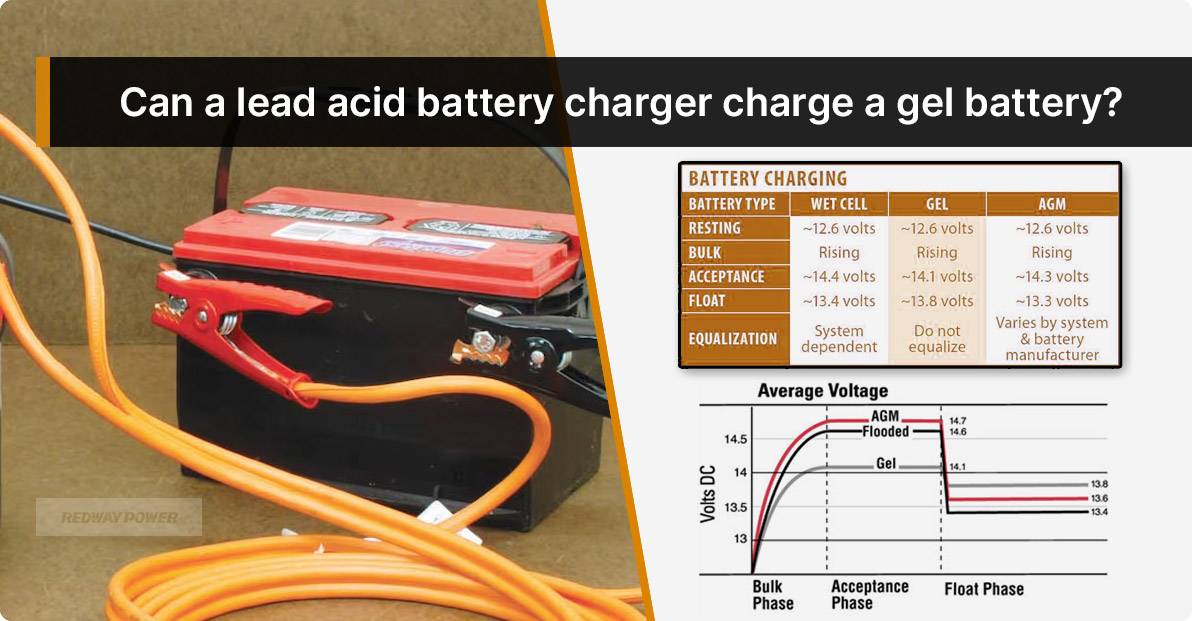
- Can I mix lead-acid and Gel batteries?
Mixing lead-acid and Gel batteries is not advisable due to differing charging characteristics and discharge rates. This can cause imbalance in the system, leading to reduced performance and potential damage to the batteries. - Are lead-acid and Gel batteries the same?
No, lead-acid and Gel batteries are not the same. Gel batteries are a subtype of lead-acid batteries that use a gel electrolyte for improved safety and maintenance-free operation, whereas traditional lead-acid batteries use liquid electrolyte. - Do Gel batteries need maintenance? Do gel batteries need acid?
Gel batteries do not require maintenance or additional acid since they are sealed. They are designed to be maintenance-free, making them convenient for users while still requiring proper charging practices. - Do lead-acid batteries work in cold weather?
Lead-acid batteries can function in cold weather but may experience reduced capacity and efficiency. It’s essential to keep them warm for optimal performance during cold conditions. - Can I replace Gel batteries with lithium?
Yes, you can replace Gel batteries with lithium ones if your system supports it. Lithium offers longer life and better performance but requires compatible charging equipment. - Is a lithium battery a Gel battery?
No, lithium batteries are distinct from Gel batteries. Lithium uses lithium compounds for energy storage, while Gel uses a gelled electrolyte within the lead-acid chemistry. - What are the advantages of a Gel battery?
Gel batteries offer advantages such as being spill-proof, requiring no maintenance, having low self-discharge rates, and tolerating deeper discharges compared to traditional flooded lead-acid batteries. - What is a Gel battery and what is lead acid?
A Gel battery is a type of sealed lead-acid battery where the electrolyte is in gel form. Lead acid refers to traditional rechargeable batteries utilizing liquid sulfuric acid as an electrolyte. - How Does a Gel Battery Operate?
A Gel battery operates by using silica-based gel to immobilize the electrolyte, allowing for efficient chemical reactions while preventing spillage. This design enhances safety and reduces maintenance needs compared to liquid electrolyte systems. - What Are the Cons of Using Gel Batteries?
Cons of using Gel batteries include lower energy density compared to lithium options, limited discharge cycles under heavy loads, and sensitivity to incorrect charging practices which can shorten lifespan. - How to Extend Gel Battery Lifespan?
To extend the lifespan of gel batteries, avoid deep discharges beyond 50%, use compatible chargers designed for gel technology, store them in cool environments, and perform regular checks on terminals for cleanliness. - How Does Heat Impact Gel Batteries?
Heat accelerates degradation in gel batteries by affecting the gel electrolyte’s stability. High temperatures can reduce capacity and lifespan; therefore, it’s crucial to store them in cool conditions for optimal performance. - What Issues Arise from Incorrect Charging?
Incorrect charging can cause overcharging or undercharging in gel batteries, leading to overheating, reduced capacity, sulfation, or even complete failure. Always use chargers specifically designed for gel technology to avoid these issues. - What Are Gel Battery Charging Requirements?
Gel battery charging requires specific voltage settings—typically around 2.30–2.35 volts per cell during absorption phase—and should use temperature-compensated chargers designed for gel technology to ensure safety and efficiency. - Why Are Gel Batteries Costly?
Gel batteries tend to be more expensive due to their advanced technology that offers better safety features and longer life expectancy compared to traditional flooded lead-acid options. Their manufacturing process also contributes to higher costs. - How does a gel battery work?
A gel battery works by suspending sulfuric acid in silica-based gel instead of liquid form. This immobilization prevents spillage while allowing efficient electrochemical reactions during discharge and charge cycles, enhancing safety and performance.

















